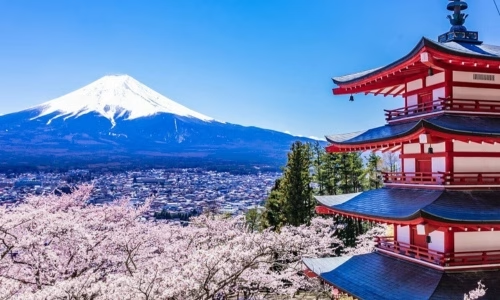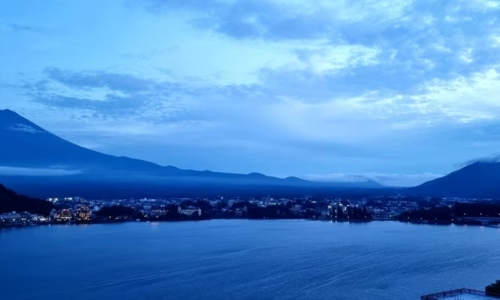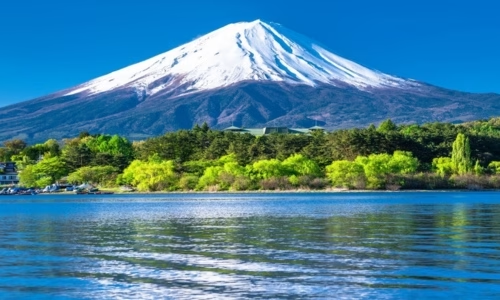Japanese Fuji isn’t just Japan’s tallest peak, it’s a timeless symbol of beauty and tradition. Rising proudly at 3,776 meters, this majestic volcano draws millions who long to visit Fuji Japan and experience its peaceful surroundings. Whether you’re eager to tackle the adventure of climbing Mount Fuji, soak in the views from nearby lakes, or explore hidden gems among the many Fuji attractions, this destination never disappoints. Planning your Mount Fuji trip? From when to go for the clearest views to tips on local sights, this guide will help you discover the best time to see Mount Fuji and how to make the most of your journey.
Introduction to Mount Fuji
Mount Fuji Japan, also known as Japanese Fuji, proudly rises to 3,776 meters, making it the highest peak in the country. Straddling the border between Yamanashi and Shizuoka prefectures, it offers more than just breathtaking scenery, it’s one of Japan’s most iconic natural landmarks. Thanks to its convenient location just a couple of hours from Tokyo, many travelers, both local and international, choose to visit Mount Fuji as a day trip or part of a longer journey.
What makes Mount Fuji truly special is not only its majestic, snow-capped symmetry, but also the deep cultural and spiritual significance it holds in Japanese history. For centuries, this sacred mountain has been a symbol of purity, strength, and endurance. Pilgrims once climbed it in search of enlightenment, and today, many still follow those paths for personal reflection or challenge.
Recognized in 2013 as a UNESCO World Cultural Heritage site, Mount Fuji’s cultural importance extends beyond religion. It has been a timeless muse for Japanese poetry, woodblock prints, and countless works of art. Whether you’re standing at its base, admiring it from afar, or reaching the summit, Japanese Fuji offers a profound sense of peace, inspiration, and connection to nature.
If you’re planning a trip from Tokyo to Fuji, you’ll find many routes, scenic spots, and seasonal highlights that make the experience unforgettable. From cherry blossoms in spring to snow-covered vistas in winter, each visit reveals a different face of this beloved mountain.

Why Visit Mount Fuji?
Mount Fuji is far more than just a picture-perfect backdrop, it stands as a timeless icon of Japan’s identity. Whether bathed in golden summer light or cloaked in shimmering winter snow, its awe-inspiring beauty draws millions each year. The mountain’s serene yet powerful presence leaves a lasting impression, no matter the season.
A trip to Mount Fuji offers something for every kind of traveler. Nature enthusiasts will be captivated by the dramatic landscapes, while photographers find endless inspiration in the ever-changing light and scenery. Those in search of a deeper connection can explore the mountain’s spiritual side, long revered in Japanese tradition as a sacred place of reflection and pilgrimage. And if you’re the adventurous type, climbing Mount Fuji or hiking its trails promises a truly rewarding challenge.
From watching the first sunrise of the day from the summit, an unforgettable experience called Goraikō, to peaceful camping trips at the mountain’s base in summer, Mount Fuji provides countless ways to connect with both nature and culture. It’s not just a destination, it’s a meaningful journey waiting to be discovered.

Travel Options from Tokyo to Mount Fuji
Getting from Tokyo to Mount Fuji is both simple and convenient, with multiple transport options suited to different travel styles and budgets.
- By Train (JR Chuo Line): For scenic views and comfort, take the JR Chuo Line from Shinjuku Station to Kawaguchiko Station. This route connects you directly to the Fuji Five Lakes area, perfect for nature lovers and first-time visitors.
- By Shinkansen + Local Bus: If you prefer speed, hop on the Tokaido Shinkansen to Shin-Fuji Station. From there, local buses take you closer to the mountain’s southern side, making this a good choice for those with a Japan Rail Pass.
- By Highway Bus: Looking for a more budget-friendly option? Direct highway buses run from Shinjuku or Tokyo Station straight to the Fuji area, with a journey time of around 2 to 2.5 hours. It’s one of the easiest ways to plan a Mount Fuji day trip or a relaxing weekend.
This range of choices makes traveling to Mount Fuji from Tokyo accessible for everyone, whether you’re an international tourist, a family with children, or a group planning a short escape from the city.
Best Time to Visit Mount Fuji: What to Expect in Each Season
Wondering when to set off for the best experience? The best time to visit Mount Fuji depends on what kind of experience you’re after, whether you’re climbing to the summit or simply admiring the view.
- Summer (July to Early September): This is the official climbing season. Trails are open, mountain huts operate, and weather conditions are relatively stable. If your goal is to reach the top, this is the safest and most popular time to go.
- Autumn (Late September to November): If you’re not planning to hike, autumn at Mount Fuji is breathtaking. The forests at the base explode in shades of red, orange, and gold, making it perfect for Fuji photography, peaceful walks, and nature sightseeing.
- Winter to Spring (December to Early April): During the colder months, Mount Fuji becomes a snow-covered spectacle. While climbing is not recommended, the snowy Fuji backdrop is ideal for quiet retreats, hot springs, and winter landscapes.
Travel Tip: Regardless of when you visit, remember that Mount Fuji’s high elevation means temperatures are cooler and weather can change rapidly. Always check the latest conditions and dress in layers to stay comfortable and safe.
Best Ways to Explore the Mount Fuji Area
Mount Fuji isn’t just a scenic backdrop, it’s a destination packed with meaningful and memorable experiences for all kinds of travelers.
- Climb Mount Fuji: For the adventurous, hiking to the summit is an unforgettable challenge. There are four main trails, Yoshida, Subashiri, Gotemba, and Fujinomiya, each varying in difficulty and scenery, catering to both beginners and experienced climbers.
- Discover the Fuji Five Lakes: Surrounding the northern base of the mountain, Kawaguchiko, Saiko, Yamanakako, Shojiko, and Motosuko each offer a unique perspective of Fuji. They’re perfect for lakeside walks, hot springs, or relaxing boat rides.
- Stroll Through Oshino Hakkai: This traditional village is known for its pristine spring-fed ponds, formed from the melted snow of Mount Fuji. It’s a peaceful place to explore Japanese culture and local treats.
- Take in the View from Chureito Pagoda: This iconic spot offers one of the best panoramic views of Mount Fuji, especially during cherry blossom season or autumn foliage. Loved by photographers and visual explorers from all over.
Photography and Viewpoint Tips for Visitors
If you’re into photography, Mount Fuji offers some of Japan’s most iconic landscapes. Essential Pointers for a Pleasant Journey:
- Choose the Right Time: Aim for early mornings or just after rainfall, these times often offer the clearest views, free from haze or clouds.
- Best Photo Locations: Don’t miss Lake Kawaguchiko, Chureito Pagoda, and Lake Tanuki, all offer postcard-worthy angles of Mount Fuji, especially during cherry blossoms or autumn leaves.
- Capture the Full Scene: Bring a wide-angle lens or use panorama mode to frame the mountain along with the surrounding beauty, whether it’s a calm lake, temple, or seasonal foliage.
Local Food to Try in the Fuji Area
After a day of exploring Mount Fuji’s scenic wonders, don’t miss the chance to enjoy some regional cuisine:
- Hōtō Noodles – A warm, comforting bowl made with thick flat noodles, pumpkin, and seasonal vegetables. This Yamanashi specialty is perfect after a cool day outdoors.
- Sakura Mochi – A springtime favorite, these sweet rice cakes are wrapped in pickled cherry blossom leaves and pair beautifully with green tea.
- Local Produce and Sake – Discover fresh mountain-grown vegetables and sample small-batch sake crafted by nearby breweries, reflecting the pure waters of Fuji.
Don’t Forget These for Your Mount Fuji Trip!
Planning ahead is key to making the most of your Mount Fuji adventure. Whether you’re hiking, sightseeing, or staying overnight, here’s what you’ll need:
- Footwear & Clothing: Wear sturdy walking shoes or hiking boots, and bring a lightweight jacket or windbreaker, even in summer, temperatures can drop quickly.
- Must-Have Gear: Pack a reusable water bottle, camera, and a backup battery to capture the views without running out of power.
- For Night Climbers: If you plan to catch the sunrise from the summit (Goraikō), bring a flashlight or headlamp, rain protection, and energizing snacks.
- Accommodation Tips: During peak seasons (like summer climbing months), hotels and mountain huts fill up fast, make reservations well in advance.
Frequently Asked Questions About Visiting Mount Fuji
- Do I need to register before climbing Mount Fuji?
You’re not required to register, but doing so is strongly advised. Signing up allows you to receive safety alerts and route updates, especially during the climbing season.
- Is there snow on Mount Fuji all year?
No. Snow typically covers the mountain from late autumn through early spring. During summer (climbing season), the trails are generally free of snow.
- Can I climb Mount Fuji in a single day?
Yes, it’s possible to do a one-day climb. However, many hikers prefer to stay overnight at a mountain hut to rest and catch the breathtaking sunrise (Goraikō) from the summit.
Conclusion
Mount Fuji is more than just a beautiful backdrop, it’s an experience that resonates deeply. With its iconic silhouette, crisp alpine air, and the sense of awe it inspires, the mountain touches everyone in a different way.
Whether you’re seeking solitude, chasing adventure with friends, or making memories with family, a visit to Mount Fuji promises a lasting impression.






Leave a Reply